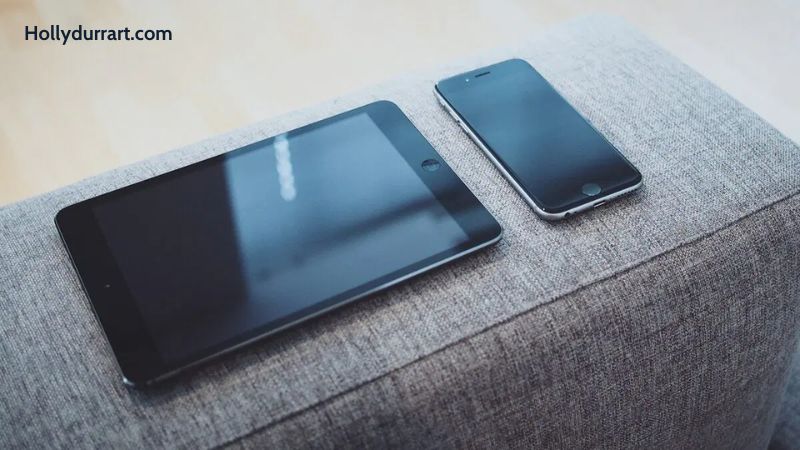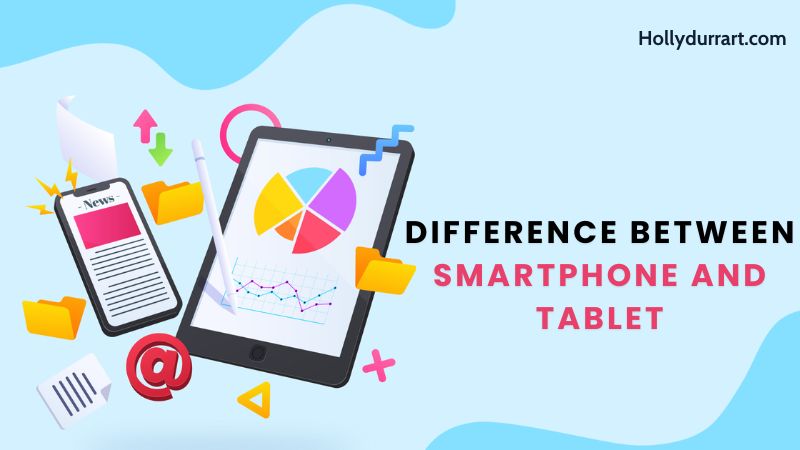In today’s rapidly evolving technological landscape, smartphones and tablets stand out as quintessential tools that have reshaped the way we interact with digital information and communicate with one another. These portable devices, though often used interchangeably, possess unique characteristics that differentiate them in terms of size, functionality, and usability. At Hollydurrart, delving into the intricacies of these devices unveils a nuanced understanding of their respective roles and applications in our daily lives. Let’s embark on a comprehensive exploration of the difference between smartphone and tablet.
Difference between smartphone and tablet: Size and Form Factor
At the forefront of the dissimilarities between smartphones and tablets lies their discrepant size and form factor. Smartphones epitomize compactness, designed to be effortlessly held in the palm of one’s hand or discreetly stowed away in a pocket. With screen dimensions typically spanning between 4 to 6 inches diagonally, smartphones prioritize portability without compromising on functionality. Conversely, tablets boast a larger form factor akin to a slate, offering a broader canvas for digital interactions. Ranging from 7 to 13 inches diagonally, tablets provide ample screen real estate for immersive experiences such as multimedia consumption, gaming, and productivity tasks. While smartphones excel in mobility, tablets cater to users seeking a more expansive viewing area for enhanced productivity and entertainment endeavors.

Difference between smartphone and tablet: Primary Functionality
The variance in size directly influences the primary functionality of smartphones and tablets. Smartphones serve as multifaceted communication devices, equipped with the ability to make calls, send messages, and access the internet seamlessly. Additionally, smartphones integrate an array of features such as cameras, GPS navigation, and a diverse spectrum of applications tailored to meet users’ productivity, entertainment, and social networking needs.
In contrast, tablets emerge as versatile computing devices, offering a comprehensive suite of functionalities encompassing web browsing, e-book reading, gaming, and content creation. While some tablets support cellular connectivity, many rely solely on Wi-Fi networks, providing users with a stationary yet feature-rich computing experience. Thus, while smartphones excel in facilitating on-the-go communication and information retrieval, tablets cater to users seeking a holistic computing experience with a larger display and enhanced capabilities.
Difference between smartphone and tablet: Portability vs. Screen Size
The dichotomy between portability and screen size delineates smartphones from tablets, each catering to distinct user preferences and usage scenarios. Smartphones epitomize portability, serving as pocketable companions ideal for users navigating bustling city streets or embarking on globetrotting adventures. With their compact dimensions and lightweight design, smartphones offer unparalleled convenience and accessibility, ensuring users remain connected and informed at all times.

Conversely, tablets prioritize screen size, providing users with a more immersive and visually engaging computing experience. Whether indulging in multimedia consumption, gaming, or productivity tasks, the expansive display of tablets enhances user engagement and productivity. While smartphones excel in mobility, tablets offer a compelling alternative for users seeking a larger canvas for content consumption and creation.
Difference between smartphone and tablet: Input Methods
While both smartphones and tablets rely predominantly on touchscreen input, nuances exist in their respective input methods, reflecting the devices’ unique form factors and usability considerations. Smartphones feature compact touchscreen displays that facilitate intuitive gestures for navigation, text input, and app interaction. In addition to touchscreen input, smartphones may incorporate physical buttons or virtual keyboards to augment the user experience.
Conversely, tablets leverage their larger touchscreen interface to accommodate more intricate gestures and interactions, fostering a seamless and immersive computing experience. Furthermore, certain tablet models may support additional input methods such as stylus pens or detachable keyboards, catering to users’ diverse productivity needs. Thus, while smartphones prioritize compactness and ease of use, tablets offer a more expansive canvas for creative expression and productivity.
Difference between smartphone and tablet: Battery Life
The disparity in size and usage patterns directly influences battery life between smartphones and tablets, with each device category offering distinct advantages and limitations in this regard. Smartphones, characterized by their smaller form factor and power-efficient components, typically exhibit shorter battery life compared to tablets. However, advancements in battery technology have led to significant improvements in smartphone endurance, enabling users to stay connected for extended periods without the need for frequent recharging.

Conversely, tablets boast larger batteries capable of sustaining prolonged usage between charges, making them ideal companions for extended productivity sessions, multimedia consumption, or gaming marathons. Thus, while smartphones prioritize portability and compactness, tablets offer enhanced battery life, ensuring users can remain productive and entertained for longer durations.
Final Thought
In conclusion, the difference between smartphone and tablet transcends mere semantics, encompassing a myriad of factors including size, functionality, portability, input methods, and battery life. While smartphones excel in mobility and on-the-go communication, tablets offer a more immersive computing experience with their larger display and versatile capabilities. By understanding the nuanced distinctions between these devices, users can make informed decisions tailored to their specific needs and preferences, ensuring they harness the full potential of modern technology in their daily lives.
